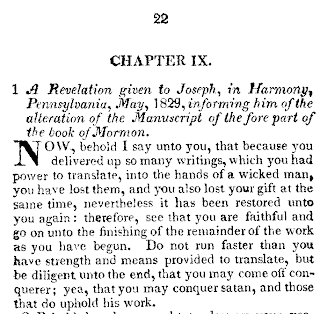Here you go:
http://www.boap.org/LDS/History/HTMLHis ... html#N_13_Note the dates in the title...
History of the Church Vol.1
Chapter 3. [Jan. 1827 - Mar. 1829]
The Nephite Record Delivered To Joseph-- The Angel's Warning--The Work of Translation.
Followed by this (note footnote 13)...
1. Now, behold, I say unto you, that because you delivered up those writings which you had power given unto you to translate by the means of the Urim and Thummim,(13) into the hands of a wicked man, you have lost them.
2. And you also lost your gift at the same time, and your mind became darkened.
3. Nevertheless, it is now restored unto you again; therefore see that you are faithful and continue on unto the finishing of the remainder of the work of translation as you have begun.
Footnote 13...
13. The term Urim and Thummim, while used in this revelation and in the ms text does not appear in early publications of the revelation, nor does it seem to have been used in any contemporary document of the principals. No early ms of this revelation survives apparently. In the 1833 Book of Commandments, verse one read "Now, behold I say unto you, that because you delivered up so many writings, which you had power to translate, into the hands of a wicked man, you have lost them. . . ." Thus, the words "by the means of the Urim and Thummim" in verse one were not part of this verse in the Book of Commandments; nor was section 17, which also makes use of the term Urim and Thummim, printed in the Book of Commandments. Both section 17 and verse one of section 10, as we now have them, first appeared in the 1835 edition of the Doctrine and Covenants. Lyndon Cook writes:
While the retroactive placement of the term in section 10 has led to some speculation relative to the Prophet's having the instrument in his possession, a preponderance of evidence confirms the Prophet's own testimony: "With the records was found a curious instrument, which the ancients called 'Urim and Thummim,' which consisted of two transparent stones set in the rim of a bow fastened to a breastplate" (History of the Church, 4:537 [Wentworth letter]). The problem here seems to be one of terminology, not whether or not the Prophet had possession of an ancient artifact. Until some time after the translation of the Book of Mormon, the sacred instruments may have been referred to as "Interpreters," or "spectacles." It is possible that Joseph Smith's inspired translation of the Bible played some part in designating the translating instrument "Urim and Thummim." The earliest use of the term Urim and Thummim in Mormon literature is in the Evening and Morning Star (January 1833). An article on the Book of Mormon, undoubtedly authored by W. W. Phelps, stated, "It was translated by the gift and power of God, by an unlearned man, through the aid of a pair of Interpreters, or spectacles--(known, perhaps in ancient days as Teraphim, or Urim and Thummim)." [RJS, 17]
[Phelps' speculation that the Old Testament word "Teraphim" refers to an object or objects similar to the Urim and Thummim is wrong. Teraphim were small household idols. Recent studies in regard to Biblical "Urim and Thummim," historically the object of wide speculation, suggest they were similar in character to the "Interpreters" had by Joseph Smith. See notes in JSCOM.]
I wonder what "preponderance of evidence" they're alluding to, to make 1833 fit under the title of 1829? Hey I know... how about an outright lie?
2 Tim 4:3 For the time will come when men will not put up with sound doctrine.
2 Tim 4:4 They will turn their ears away from the truth & turn aside to myths
